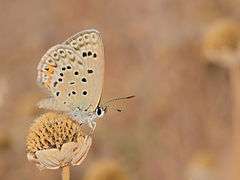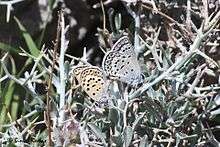Plebejidea loewii
Plebejidea loewii, the large jewel blue,[2][3] is a species of blue (Lycaenidae) butterfly.
| Large jewel blue | |
|---|---|
 | |
| Scientific classification | |
| Kingdom: | |
| Phylum: | |
| Class: | |
| Order: | |
| Family: | |
| Genus: | |
| Species: | P. loewii |
| Binomial name | |
| Plebejidea loewii | |
| Synonyms | |
| |
Description from Seitz
L. loewii Z. (= empyrea Frr.) (78 i). Has the appearance of a small form of the preced ing [L. aliardii] ; male above very vividly glossy blue, almost as in bellargus but darker; the female above brown with yellowish red spots in the anal area of the hindwing. Underside with an abundance of ocelli, behind the red submarginal band of the hindwing there are metallic dots. Asia Minor, Armenia, Persia and Turkestan. — The large form gigas Stgr. (78 i, k), from Syria, resembles especially lycidas but the ocelli of the hindwing beneath are larger and placed closer together; moreover, the characteristic intense blue gloss, which no other Blue has in the same tint, is as strong in gigas as in true loewii. — But another form, which flies at Sharud and in Baluchistan and agrees in size with true loewii, is said to be paler violet-blue and has been named chamanica Moore [now full species]. In May and June, locally plentiful.[4]
Range
Northeast Africa, Aegean Islands, Turkey, Syria, Israel, Jordan, Caucasus and Transcaucasia, Russia (Central Caucasus), Iran, Tajikistan, Turkmenistan, Afghanistan[5][6]
Subspecies

- P. l. loewii (Armenia: highland)
- P. l. uranicola (Walker, 1870) (Jordan, Egypt, the Sinai, the Negev, central Saudi Arabia, UAE, Oman)
- P. l. antilibanotica (Hemming, 1929) (Lebanon)
- P. l. laura (Evans, 1932)
- P. l. dzhemagati (Sheljuzhko, 1934) (Caucasus Major)
- P. l. schwingenschussi (Pfeiffer, 1937) (Talysh Mountains)
- P. l. hissarica (Shchetkin, 1963) (Ghissar)
- P. l. afghana (Howarth & Povolny, 1976) (Afghanistan)
- P. l. battenfeldi(Rose & Schurian, 1977) (Iran)
- P. l. hofmanni (Rose & Schurian, 1977) (Iran)
Ecology
This species lives very locally on dry stony meadows and other xerophytic biotopes or subalpine meadows. One generation per year. Flight time in June - early August. Female are much less common than males and practically do not leave their habitats. After mating, the female lays one egg each on the stems and leaves of the forage plants of caterpillars - Astragalus spp. Egg discoid, with pronounced cells on the surface. Its color is white with a greenish tinge, the micropyle is green. Eggs hibernate with the already formed caterpillar inside. Caterpillars of the first age are yellowish-green with dark dots and a brownish-black head. They eat up the parenchyma of the leaves, scrape off the juicy inner parts of the stipules, but especially prefer to penetrate into the young buds and eat in them. Caterpillars of the senior, the fifth, age are bright green with a black head. They feed on buds and flowers. By the end of their development, they sometimes acquire a reddish hue. Puppies in shelters - under the bushes of a forage plant or in cracks in the soil, attaching to the substrate a spider's loop. The length of the pupa is 11-12 mm. It is elongated, light green with a dark green dorsal stripe and white spiracles, covered with very short white hairs. The pupa stage is 12-15 days[7]
Cited references
- Zeller, 1847 Verzeichnis der vom Professor Dr. Loew in der Türkei und Asien gesammelten Lepidoptera Isis von Oken 1847 (1) : 3-39
- Plebejidea at Markku Savela's Lepidoptera and some other life forms
- Beccaloni, G.; Scoble, M.; Kitching, I.; Simonsen, T.; Robinson, G.; Pitkin, B.; Hine, A.; Lyal, C., eds. (2003). "Plebejidea loewii". The Global Lepidoptera Names Index. Natural History Museum. Retrieved April 23, 2018.
- Seitz, A. ed. Band 1: Abt. 1, Die Großschmetterlinge des palaearktischen Faunengebietes, Die palaearktischen Tagfalter, 1909, 379 Seiten, mit 89 kolorierten Tafeln (3470 Figuren)

- Львовский А. Л., Моргун Д. В. Определители по флоре и фауне России. Выпуск 8 // Булавоусые чешуекрылые Восточной Европы. — М.: Товарищество научных изданий КМК, 2007. — 443 с. — 2000 экз. — ISBN 978-5-87317-362-4
- Сочивко А.В., Каабак Л.В. Определитель бабочек России. Дневные бабочки. — М.: Аванта+, 2012. — 320 с. — 5000 экз. — ISBN 978-5-98986-669-4
- СТРАДОМСКИЙ, Б. В. (2017): Стадии развития Plebejidea loewii (Zeller, 1847) (Lepidoptera: Lycaenidae) [STRADOMSKY, B. V. (2017): The developmental stages of Plebejidea loewii(Zeller, 1847) (Lepidoptera: Lycaenidae)]. — Кавказский энтомологический бюллетень 13 (1): 125-126
References
- Beccaloni, George; Scoble, Malcolm; Kitching, Ian; Simonsen, Thomas; Robinson, Gaden; Pitkin, Brian; Hine, Adrian; Lyal, Chris. "The Global Lepidoptera Names Index (LepIndex)". Natural History Museum, London. Retrieved 2016-10-15.
- "Markku Savela's website on Lepidoptera".